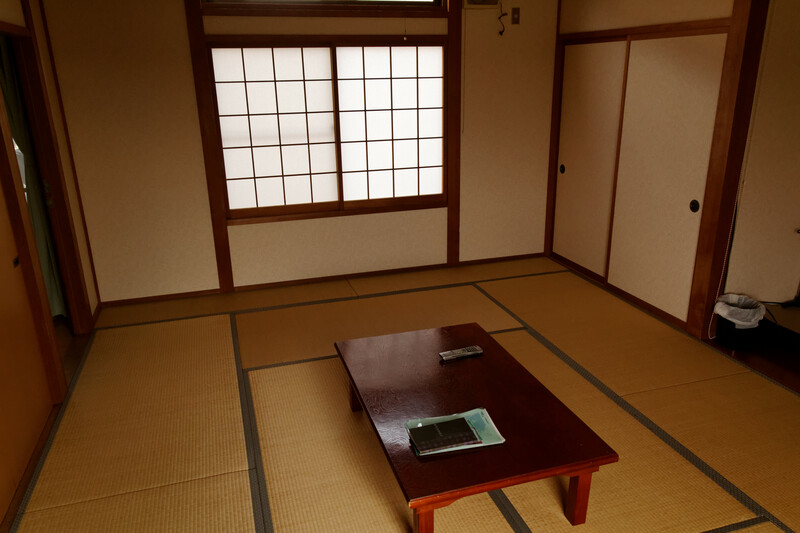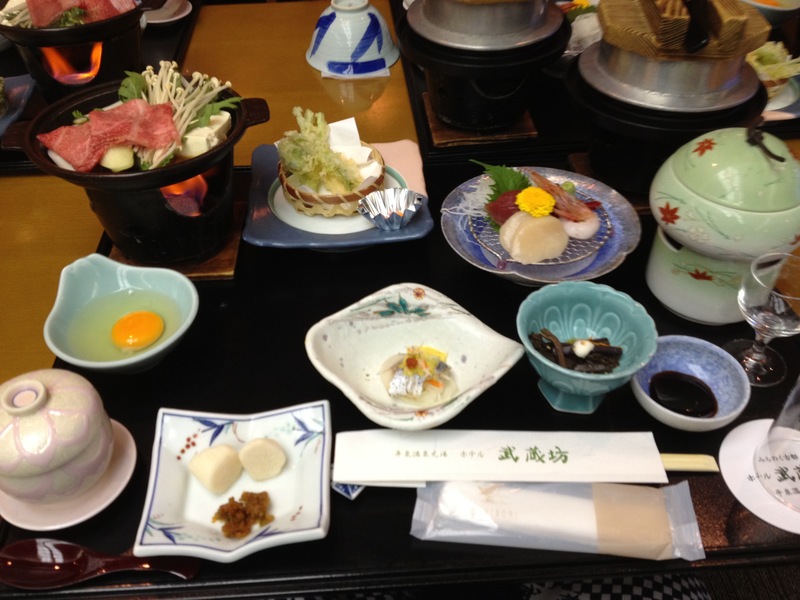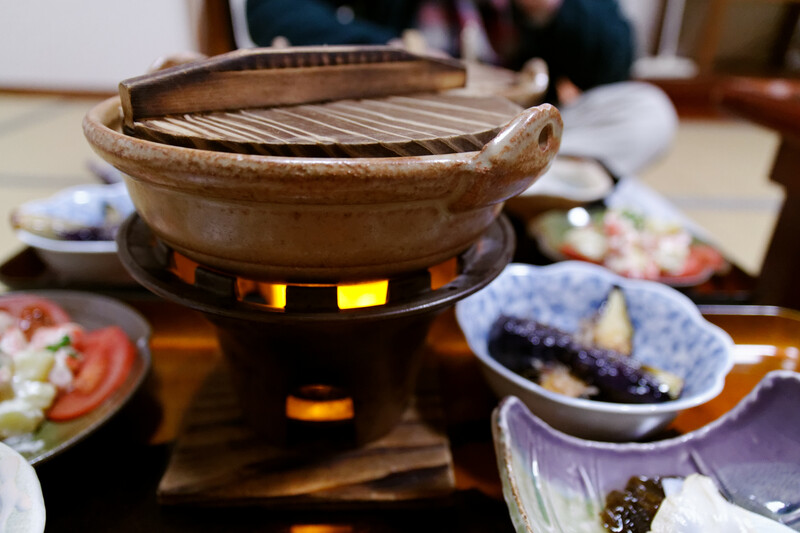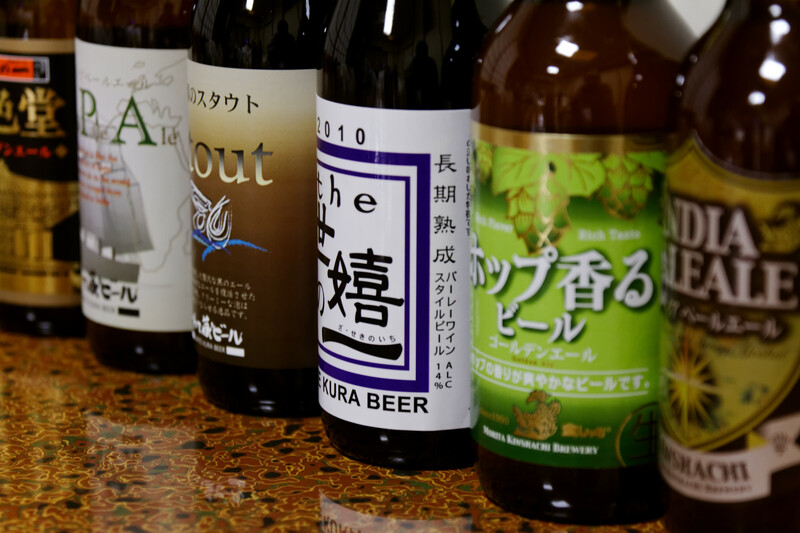Ryokan

Minshuku room, Oku-Matsushima |
In Japanese language, no articles. In Japanese hotel room, not many articles, either. Actually, that's not quite true. Japanese hotel rooms are much like their western counterparts, but the traditional Japanese inns are something else entirely. There's two main kinds: the expensive ryokan, and the cheaper minshukus.
Entering the room is a bit of a shock, because there really is nothing there. The room has tatami matting and may contain a very low table, perhaps 10 cm off the floor, and some legless chairs. Sometimes there's a TV. There's a separate bathroom, and some sliding doors. That's it. You'll note the complete absence of beds. Closer investigation will reveal that behind the sliding doors are shelves where you can find thin mattresses, pillows, and duvets. Those are your beds.
This arrangement may sound crazy, but it's actually very practical. Japan is a very crowded place, and this way you can have a number of people in a small room without it being cramped because the space isn't all taken up by furniture. And when you go to bed, the room, although small, has space for a substantial number of people, since everyone just uses mats on the floor.

Legless chairs, Matsumoto |
The minshukus are usually fairly simple places, but the ryokans are more sophisticated. We stayed at a ryokan in Hiraizumi. From the outside it was ... ugly. There's no other word for it. A low concrete lump in a depressing greenish gray colour, with no real decoration of any sort. Inside, my first impression was that it was a little run down, but basically OK. It seemed like they'd built the place in the 70s, and then never touched it again, other than to clean it.
After a while I started noticing that in the corridors were a number of floor-to-ceiling windows, and each of these opened onto carefully manicured gardens. The place was actually kind of beautiful, if you looked at it in the right way.
These places always have a communal bath, sometimes just a shared bathtub. The ryokan, however, actually had a full onsen (bathhouse), so we headed there before dinner. The first step, obviously, is to undress. Then you shower, sitting on a small stool, cleaning and scrubbing yourself thoroughly. Then you can go in the bath. They do it this way so everyone can use the same water, saving energy.
The bath itself was nothing special, a smallish pool of very hot water done out in black stone. Still, it's a great feeling to slowly lower yourself into the boiling water, feeling the body slowly turn to jelly in the heat. This bath was unusual in having big panorama windows. These looked out onto a bamboo grove, which grew on the edge of a slope, so that the trees at the top were thin, not obscuring the view much. People couldn't really see into the bath because of the slope and the bamboo, but inside we were treated to a view of bamboo plants silhouetted against the sky, lazily dancing in the wind. It was surprisingly beautiful, and very calming to watch.
It was clear that a fair bit of thought had gone into positioning the bath, and arranging the gardens around it to provide exactly the right combination of privacy and something beautiful to look at. It follows that the architects had decided that this was much more important than providing the bath with any sort of ostentatious luxury. Again, surprising sophistication and even beauty, hidden behind a seemingly austere surface.

In yukata and vest |
After the bath, another quick shower followed. Then, true to tradition, we did not put on our clothes. Instead, it was time for the yukata, the thin Japanese bathrobe. When it's warm, the yukata is actually much superior to the thick western bathrobes, because the thin cotton allows the heat and dampness to escape, while keeping you pleasantly warm. On top, we put a kind of vest, and then put on the obligatory slippers.
Then we were ready for dinner. So we headed off to the Benkei banquet hall, still in our yukatas and slippers, to join other guests similarly attired, for the communal dinner. We never ordered, as far as I could tell. Instead, the waiters just started bringing dishes, and they kept at it for a good while. When they left, I just stared at the amazing array of dishes in total confusion. Where to begin?

Dinner (detail) |
Three dishes had a little candle heating them from underneath, so that they were cooking right on the table. One of these I recognized as sukiyaki, another looked like some kind of white pudding. One bowl held a raw egg, and nothing else. There was a big tempura shrimp, some pickled bamboo, bits of seaweed, soy sauce, some sashimi, and a whole bunch of other things I couldn't tell what were.

Cooking on the table, Oku-Matsushima |
Thankfully, Naito-san was there to explain. The egg was the sauce for the sukiyaki. This sauce went with that dish, the bowl here was such-and-such, to be eaten as it was, and so on and so forth. As we ate, I started feeling amazingly well. Tired from all the walking, deliciously relaxed from the bath, and very much enjoying all this strange Japanese food. Plus, I was all dressed up in Japanese costume. It was like we were all taking part in a kind of Japanese cultural exhibition, except that it was entirely real.
Finally, it was off to our room, where we'd gathered 20 bottles of Japanese craft beer, which we proceeded to taste. While sitting on the floor, since there was nowhere else to sit. That gets challenging after an hour or so, and certainly after a good number of beers. Eventually we gave up on getting through all the beers, arranged our mats on the floor, laid down, and immediately passed out.

Ready to taste |
Similar posts
Dogo Beer
Dogo is a small onsen (Japanese bath) town near Matsuyama on the island of Shikoku
Read | 2007-06-28 22:23
The Kiso valley
In Tokugawa-era Japan (1600-1868) travellers had two main roads to choose between when travelling between the official imperial capital of Kyoto and the seat of power, which was Tokyo (then called Edo)
Read | 2008-05-24 12:52
Into the tsunami zone
The March 2011 earthquake and tsunami must be one of the most widely reported stories ever, so does the world really need another account
Read | 2013-01-04 13:54
Comments
Dave Pawson - 2012-09-29 04:09:03
Sounds rather enjoyable... though my lack of adventurous tastes prohibited me from trying many of the dishes when offered them in Japan. Very handy to have a local to explain though. At least your can avoid those that sound ... odd.
I note the (mandatory?) beerfest afterwards?
Dave
Lars Marius - 2012-10-01 14:45:22
@Dave: I don't believe beer tastings are mandatory when staying at ryokans, but, you know, lugging that stuff around is hard work, and we had to lighten the load.
Piotr - 2019-03-09 09:55:01
Funny you mention Kapuscinski. Do you know he was a collaborator of the communist secret police which adds a new dimension to his creative activities?